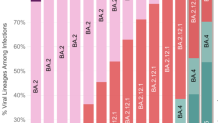It appears a new subvariant of the virus that causes COVID-19 has started to take over the spotlight. According to models the U.S. Centers for Disease Control and Prevention updated on Tuesday, BA.5 is now the dominant strain in the country, making up an estimated 53.6% of infections.
The CDC's new data shows BA.5 is also the dominant strain in the region of the country that includes California, making up an estimated 51.9% of infections there.
Not only is BA.5 more contagious than previous subvariants, but early research shows it appears to be both vaccine and immunity resistant, meaning those who have had COVID before, even recently, are not protected from infection, health officials said.

Get a weekly recap of the latest San Francisco Bay Area housing news. Sign up for NBC Bay Area’s Housing Deconstructed newsletter.
"It's gonna be harder and harder for people to make it through these waves without getting infected,” noted Dr. Abraar Karan, who specializes in infectious diseases at Stanford University. Not only has Karan been working on the public health and clinical response to COVID-19 throughout the pandemic, he also has firsthand experience with just how infectious the evolving Omicron variants are.
As the San Francisco Chronicle first reported, Karan got COVID-19 twice in the past six months despite successfully dodging it for the past two years of the pandemic.
Karan explained to NBC Bay Area that he first contracted COVID-19 in January in what he believes was a household transmission from his significant other. He said he felt "wiped out" after that infection and it took him until April to feel fully recovered.
But then, on a morning in late May before working in a clinical setting, he felt a tickle in his throat and decided to take a COVID-19 test. Despite being vaccinated, boosted, and having a recent prior infection, Karan yet again tested positive.
Local
Karan believes he contracted earlier Omicron subvariants. He has family members who were more recently infected and he thinks it is likely they contracted the BA.5 variant.
To avoid more repeat infections, Karan said he is now adjusting his behavior.
“It spreads best where there’s poor ventilation, the more I can avoid those particular situations the better,” he said.
While vaccines may not prevent you from getting infected with new subvariants, Karan reiterated that getting vaccinated and boosted is still the best way to protect against severe illness and death.
But Karan noted, that when there are high levels of community transmission and increasingly small numbers of people wearing effective masks, there is only so much individuals can do to protect themselves. Karan believes governments can do more to require masking in certain settings and to improve air circulation.
Plus, Karan noted, that while it seems clear more people will get repeat COVID-19 infections, what is less clear is how exactly those repeat infections will impact our overall health.
"When the government says it's OK to get infected because we have clinical tools to keep you from getting on a ventilator or dying, yeah that’s true, but we also have to be clear with people that we don’t know for sure what it means for your morbidity and long term to get repeat infections like this,” Karan explained.
Santa Clara County shared that since June 5, around 8.5% of the COVID-19 cases in the county have been documented reinfections.
At the county's COVID-19 testing site at the county fairground on Tuesday, a steady stream of cars kept filing through the tents, pausing so that drivers could get their noses swabbed.
Andre Lai of San Jose went there to get tested because his girlfriend tested positive recently.
"With the recent surge and stuff, I’m just more cautious,” Lai said, adding that he lives with his grandparents and wants to help keep them safe.
“There’s still so much more information to learn," Lai said about the new subvariants. "It’s really hard to tell how it's going to be a year from now.”



